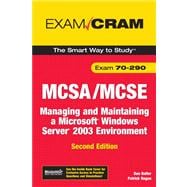MCSA/MCSE 70-290 Exam Cram: Managing and Maintaining a Microsoft® Windows Server® 2003 Environment Second Edition
The Smart Way to Study™
Covers the critical information you’ll need to know to score higher on your 70-290 exam!
- Set up and maintain Windows Server Update Services (WSUS)
- Use the Group Policy Management Console (GPMC)
- Intelligently select the appropriate disk storage technology when deciding between basic versus dynamic disks and between MBR versus GPT disks
- Take advantage of command-line tools such as DSADD, DSGET, DSMOD, DSMOVE, DSQUERY, and DSRM
- Discover the enhanced functionality of Microsoft Management Console (MMC) 3.0 under the R2 edition of Windows Server 2003
- Harness the power of the increased security that Service Pack 1 (SP1) offers, such as the Security Configuration Wizard (SCW) and Access-based Enumeration filtering of network files and folders
- Perform bulk imports and exports of Active Directory user accounts using the CSVDE and LDIFDE command-line utilities
- Manage Windows Firewall settings under SP1 and R2
- Configure shadow copies of shared folders so that users can easily retrieve previous versions of data files on their own
WRITTEN BY LEADING 70-290 EXPERTs:
Dan Balter is the chief technology officer for InfoTechnology Partners, Inc., a Microsoft Certified Partner company. He works as an IT consultant and trainer for both corporate and government clients and has worked with several network operating systems throughout his 24-year career. Dan holds the following Microsoft certifications: MCDST, MCSA, and MCSE.
Patrick Regan is a senior design architect/engineer and training coordinator for Miles Consulting Corp (MCC). He holds many certifications, including the Microsoft MCSE, MCSA, and MCT; CompTIA’s A+, Network+, Server+, Linux+, Security+, and CTT+; Cisco CCNA; and Novell’s CNE and CWNP.









